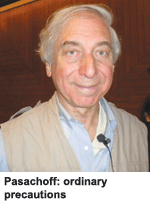Inevitably, internationally renowned astrophysicist and astronomer Prof. Jay Pasachoff, on his 49th solar eclipse experimental expedition, was in Kanyakumari, Tamil Nadu, the best vantage point to view the solar eclipse of January 15, when the sun formed a spectacular ring of fire around the moon. Subsequently during a stopover in Delhi, he made time to address school children at the behest of the Nehru Planetarium and Delhi-based Science Popularization Association of Communicators and Educators. His advice to them: shun the superstitions associated with celestial events and enjoy them as scientific phenomena. “This branch of science is becoming exciting and in the near future we will be able to see 3D images of the sun during an eclipse,” Pasachoff, an alumnus of Harvard University and currently professor at William College (USA), told the children’s assembly.
 A recipient of the 2003 Education Prize of the American Astronomical Society for authoring illuminating textbooks sharing the joy of observing eclipses with the world, and his intense advocacy of science education in various forums, Pasachoff is the chair of the working group of the International Astronomical Union on eclipses. A renowned authority on eclipses, Pasachoff, who has followed, studied and analysed 49 solar eclipses, is showered with research grants by the National Science Foundation, NASA, the National Geographic Society, among other prestigious organisations and institutions.
A recipient of the 2003 Education Prize of the American Astronomical Society for authoring illuminating textbooks sharing the joy of observing eclipses with the world, and his intense advocacy of science education in various forums, Pasachoff is the chair of the working group of the International Astronomical Union on eclipses. A renowned authority on eclipses, Pasachoff, who has followed, studied and analysed 49 solar eclipses, is showered with research grants by the National Science Foundation, NASA, the National Geographic Society, among other prestigious organisations and institutions.
Rubbishing popular myths about viewing the sun during an eclipse, Passachoff advised children to take ordinary precautions. “Widespread fear of eclipses and their bad outcomes for people, especially pregnant women is not substantiated by evidence. However the sun shouldn’t be viewed without protective eyewear during eclipses or otherwise. Doing so can damage eyesight. Simple devices like graters can be used to create pin hole images of the sun, apart from standard filters. Remem-ber, the lens of your eye is like a magnifying glass that burns leaves in sunlight. Damage to the retina can be caused if it’s viewed through naked eyes,” he said.
In a country where the practice of choosing an auspicious time according to the position of the sun and planets is deeply embedded in the everyday lives of people ranging from the prime minister to rural bridegrooms, promoting the study of astronomy over astrology is a big challenge for educators, admits Pasachoff. “Public education is the best option to help preserve vedic astronomy and promote western research. We are moving towards a greater understanding of activities on and around the sun. I am optimistic that we’ll soon learn a great deal about fusion power which will contribute significantly to energy generation technologies on earth,” he predicts.
Autar Nehru (Delhi)